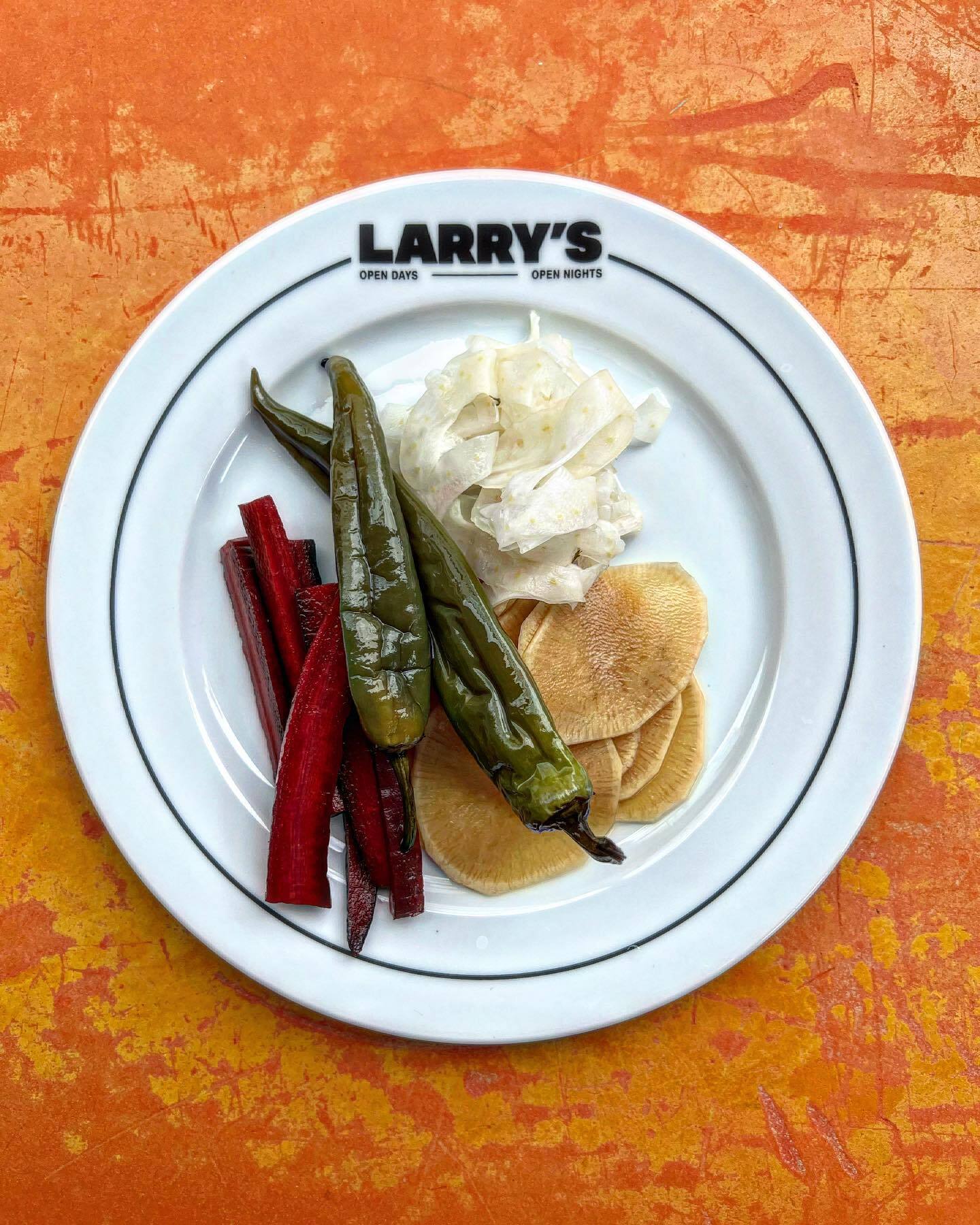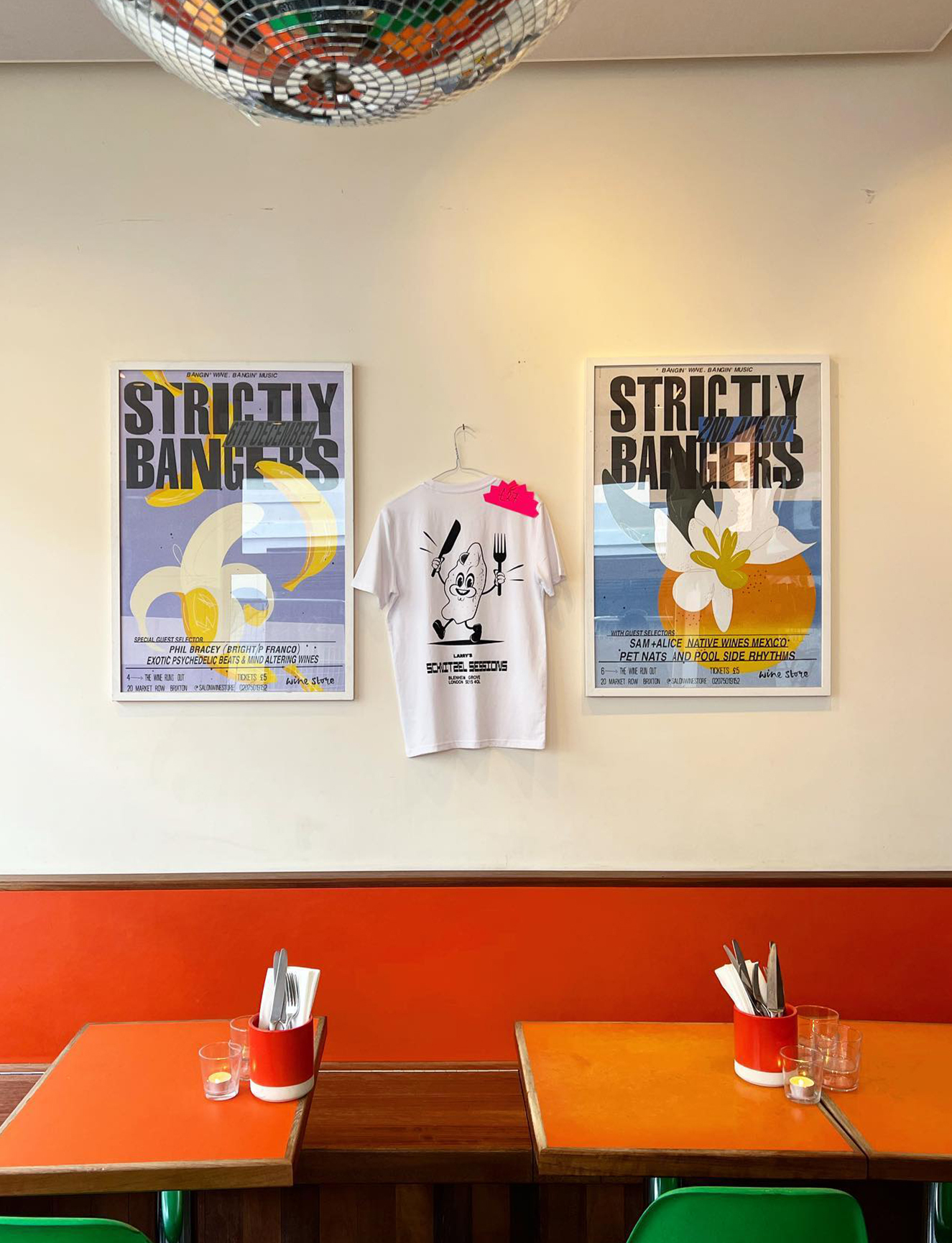I want to start by talking about Larry’s visual identity. It feels that a strong visual identity is so important to restaurants today, especially in terms of Instagram. Can you speak a little on how aesthetics shape restaurants?
I think with Larry’s we had an opportunity to do something a bit more fun. We’ve worked with the same architect on Levan, Larry’s and HOLM, an architect called Gundry + Ducker, and we mostly work with a guy called Ty, who is one of the partners. Ty is wicked, he has great vision and is always to give us a really strong aesthetic for our businesses.

With Larry’s the original concept was around our love of New York, and wanting to do something New York-like, in large part because of where the site was: on a corner, in Peckham, it felt like it needed to be a ‘Frank’s’ or a ‘Jimmy’s’ on a New York street corner. So we thought, ‘We need to make this quite fun, interesting and bright’, like New York is really.
Then aspects like the colour scheme came together quite naturally. The colour scheme of the restaurant is actually based around the chairs; these beautiful Herman Miller designed chairs, that a friend helped us source. The chairs are very bright green, and we needed something to offset that green, so the orange came about as a natural companion.
What elements of that New York dining culture did you want to replicate?
The melting pot of cuisine I suppose, and the energy. Bringing together Far Eastern flavours, Chinese Taiwanese, Korean, blending it with Italian, so lots of pasta, and then also that Jewish element, deli Reuben sandwiches, and things like that. Then an all-day offering was important to us on that theme too, so breakfast and coffee, through lunch, and then dinner, and kind of melding all those things together.
The original concept was around our love of New York

Larry’s was set to open right when the pandemic hit, what was that experience like, and how did you come through it?
We had started putting in the plans for opening Larry’s before the spectre of the COVID pandemic hit, so we were committed from well before. But also, we just didn’t think COVID was going to happen, we always had that hope that maybe it would pass us by – how naive! We opened, and it was one of the hardest experiences I think I’ve ever been through; we had to tell all our teams that we were having to shut, and that we didn’t know what was going on. The uncertainty was crushing and it was really difficult, having to open a restaurant and close it the same week was not very pleasant.
With Larry’s it’s definitely been more of a challenge overall opening it. When we opened Levan it was quite a clear, easy path to building a buzz around it, whereas Larry’s has taken much longer to build, and it’s been a bit more of a slow burn trying to get it back up, and build its reputation. It’s been interesting, it’s been a tough one for Larry’s. I think it’s been easier for the other restaurants because of the lack of barriers to opening.

It feels like a really interesting time for London’s restaurants and food scene, with new critics emerging who work outside of broadsheets, and a lot of hype around newly opened restaurants. Can you speak a little on how that feels?
I think it’s really vibrant at the moment in London, and it feels like it’s evolving a little bit. Obviously a lot of things have changed over the last few years; lots of good restaurants have folded and shut, others have sprung up and opened. It feels like it’s been a bit of a churn, and a new launching point. All sorts of new people are coming through to start their own restaurants, which is great.
I now eat more in the peripheries of London
I now eat more in the peripheries of London than I do in central London. I think central London feels like the bastion, the place where people come to from outside of London to eat, whereas Londoners either stick to their neighbourhoods or go to other neighbourhoods. For me that’s been a real movement that’s been happening over quite a few years, but I think it’s even more the case now. I drink locally, I go out locally. I don’t really go into town that much. We’re surrounded, in South London or in East London, where I live, by fantastic places, so why do I need to go into a big swanky central London restaurant.
For you, what’s the biggest challenge of setting up a restaurant?
Finding a good site, and something that really works, which is often either luck or good fortune. Then the other most challenging thing is making sure your concept is right, and that people get it, that it’s really simple to understand. Anything too complicated and it starts getting a bit woolly. After that, getting good staff. In any industry that’s super important, but it’s critical in hospitality, and especially now, post-Brexit. As an industry we’ve been absolutely hammered by Brexit and COVID, it’s definitely a lot harder to find good people.

And then on the flip side, what’s the most rewarding thing about it?
Having people come in and say, “That was the best thing I’ve eaten in a long time or ever,” or, “That was the most amazing dish,” and seeing people walk out really happy. I think anyone in hospitality has to have that in them, otherwise they wouldn’t do it. I’ve worked in a number of different careers in my life, and in a lot of industries you don’t get any feedback. That’s one of the beautiful things about hospitality, that people come up to you and shake your hand and say, “That was stunning, thank you, you really made my evening.” That’s what we do it for.
Read More: Coming Full Circle With Mangal II






